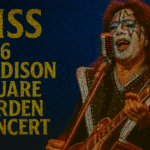Sam Rivers, the foundational pulse of Limp Bizkit, has died at 48, leaving a hole in a band that called him “our brother, our bandmate, our heartbeat.” The news arrived in the band’s social post announcing his death on October 18; bandmates remembered Rivers as “pure magic,” praising his effortless talent, unforgettable presence, and enormous heart. For fans and fellow musicians, the loss lands like a silence after a roar — sudden, disorienting, and deeply felt.
Rivers’ bass playing was more than low-end support; it was the engine that propelled Limp Bizkit’s sound. Across the band’s rise, his lines threaded groove into aggression, offering a steady, soulful counterpoint to the roars, samples, and breakbeats that surrounded them. He was indispensable in translating raw energy into songs that moved stadiums and defined a generation’s late-90s crossover between metal, hip-hop, and alternative rock. Band members and collaborators consistently leaned on his rhythmic judgment and calming presence during the chaos of life on the road, and those qualities showed through in the music and the way he carried himself offstage.
The circumstances around Rivers’ death were not fully detailed in the initial announcements; the band did not disclose a cause when they shared the news with fans. In their Instagram statement, Fred Durst, Wes Borland, John Otto, and DJ Lethal spoke with a mix of grief and gratitude, calling Rivers the “pulse beneath every song,” a “calm in the chaos,” and “the soul in the sound.” Their words read like a catalog of small, essential things that made Rivers irreplaceable: the human rhythms he laid down, the light he brought to rooms, and the way his musicianship anchored the band’s sometimes volatile chemistry.
Rivers’ musical life began long before stadium tours. He was a co‑founder of Limp Bizkit and a constant through the band’s transitions from dense club circuits to multi-platinum visibility. His approach blended a blues-rooted feel with the heavy, rhythmic insistence required by nu‑metal — a style that made the group both immediate and oddly melodic in its early records. Those records, and the live shows that followed, rested on the kind of taste and restraint that Rivers offered: he knew when a note should punch and when silence would land harder. That musical restraint made him a musician’s musician and gave the band a foundation that other elements could build on without toppling the song’s heartbeat.
Beyond his instrumental role, Rivers’ reputation among peers and fans was built on character as much as craft. Accounts from touring colleagues and those who worked with him describe a warm, steady presence: someone who could steady a room, keep perspective, and offer a wry or generous response when needed. The band’s public tribute highlights this facet of his life, emphasizing the large-heartedness and light he brought into the group dynamic. Those who loved him now speak of memory-laden moments: late‑night conversations, the groove he dropped into a rehearsal that changed a song, the laugh that cut tension. That human texture is often the part of an artist’s life that outlives credits and charts.
It’s also important to note Rivers’ history with health struggles; reports indicate a past diagnosis linked to alcohol-related liver disease. While early announcements did not connect that history directly to his death, it frames a life that included battles offstage as well as breakthroughs on it. These struggles, and the ways he navigated them, become part of the fuller portrait fans and friends will carry forward as they remember him not just as a musician but as a person with a difficult, complicated humanity.
The cultural imprint of Rivers and Limp Bizkit is complicated and enduring. The band’s sound and spectacle arrived at a moment when genre lines were being redrawn, and Rivers’ low end helped make aggressive, hybrid music feel cohesive rather than chaotic. For listeners who first found them in the late 1990s and early 2000s, Rivers’ basslines are woven into memories of concerts, car rides, and formative playlists. For newer listeners, his playing remains a study in how groove can give weight and direction to loud music. That dual legacy—intense fan devotion and ongoing musical relevance—means the loss resonates across generations.
Public mourning for musicians often unfolds in two waves: an immediate rush of tribute posts and remembrances, and a longer reckoning as catalogues are revisited and contextualized. In the days after Rivers’ death, fans and fellow artists shared clips, set lists, and personal memories on social platforms; the band’s statement anchored those expressions in gratitude and heartbreak. Over time, Rivers’ work will likely be reassessed and reheard, not as a footnote to a controversial era but as the contribution of an artist who anchored a band’s sound and helped shape a cultural moment.
Sam Rivers’ passing leaves behind recordings and performances that will continue to speak. He was a co‑founder, a bass player with an ear for the essential, and a presence whose steadiness allowed chaotic musical impulses to cohere into something lasting. The immediate shock and sorrow are raw, but they arrive alongside stories of a musician whose low end was also the heart of the band—proof that rhythm can be both a technical skill and a kind of emotional center. As fans listen again to the grooves he laid down, they will hear not only riffs and lines but the imprint of a life lived inside music.










